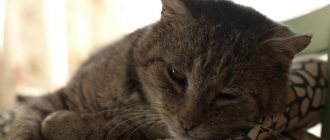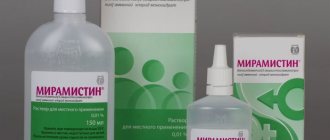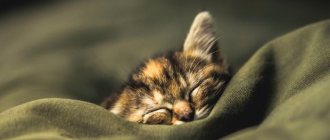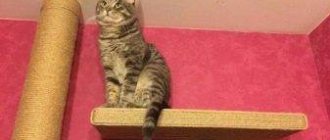When a small British cat appears in your home, you should think not only about how to take care of him, but also about how to raise him. Yes, this breed of cat is not much different from ordinary cats, but they have one twist. And this is their highest intelligence! It is because of this that owners need to have a certain approach.
Naturally, when you see a little fluffy bear in front of you, it seems that he is the best in the world. However, each kitten has its own character and its own rules, but it is worth considering that he lives in your house, then it is you who needs to establish rules for him from the first day.
British kids, like children, if you put something in them from the very beginning, it will be the key to success.
Cats of this breed are often very calm and balanced, but this does not mean that they will not be playful. Moreover, all small pets have incredible energy and curiosity.
At what age is it better to adopt a kitten?
Owners who are not familiar with the characteristics of the breed try to pick up a British kitten from a breeder at the age of 5-8 weeks. You should not do this, since caring for a pet at this age can be difficult. Of course, I want to watch the baby grow. However, early separation from your cat can have dire consequences for the kitten's health.
The appropriate age for moving to a new home is 10-12 weeks. By this time, the Briton is no longer dependent on his mother. He received a full course of breastfeeding, so his immunity is less vulnerable.
As a rule, a kitten at 12 weeks is already accustomed to the tray and knows how to use a scratching post. But the most important thing is that upon reaching the age of three months, the first vaccination against deadly diseases is carried out:
- rabies;
- chlamydia;
- panleukopenia;
- calcivirosis.
Taking an unvaccinated British kitten from a cattery is risky. Moreover, in case of complications after vaccination, the problems will fall on the shoulders of the new owner, not the breeder.
The main indicator is age
A kitten is a child with fur and a tail, which means it needs to be treated as such. Raising little kittens is always associated with pranks, disobedience, and later with rebellions of adolescence. Before you start training your pet, you need to assess its physical and psychological age.
From birth to 2 months, kittens are under the care of their mother. Kids actively communicate with each other and learn to build relationships. Essentially, at this stage, the quadruped goes through a process of basic socialization. Children have their first conflicts, and they resolve them as best they can; some fight, others silently retreat. At this age, kittens do not yet fully control their own bodies, but every day they become more and more confident in themselves and their abilities.
If you become the parent of an orphaned kitten, then the main task becomes survival. Feeding such a baby is not easy. The kitten needs to be bottle-fed every 2-4 hours, warmed and protected. A separate topic is the correct choice of food products, since whole and store-bought cow’s milk is not suitable for babies. The best choice is powdered cat milk replacer. You will have to massage your baby's stomach and genital area with a warm, damp cloth, otherwise he simply will not be able to go to the toilet.
As soon as the baby has opened his eyes, mastered complementary feeding and confidently stood on his paws, he can prepare to move to a new home. At this age, the main aspect is a complete and balanced diet. However, the kitten will face a lot of stress - moving, change of owner, environment and daily routine. Try to smooth out the baby’s experiences as much as possible, maintain the usual daily routine and food intake, take from the breeder or curator some of the bedding that will smell (for a while) of the mother.
Next, you will watch your ward grow up, not by months, but by days. The baby will begin to master running, jumping and other tasks that are difficult for his age. The kitten will realize that he is quite strong and will begin to climb all kinds of surfaces.
Around this age, you need to start raising your baby, but the main attention should be paid to his safety. The baby may already understand the meaning of boundaries, so try to isolate the kitten in a room, house or carrier for the period of time until you can monitor it
It is necessary to pay special attention to the equipment of the rest area. The kitten will need a house, which can be bought or made at home.
As soon as the baby goes to his place, do not disturb him. Your pet should be sure that he can step away from the hustle and bustle and be in complete peace and safety.
Up to 4 months the baby will grow by leaps and bounds, play and sleep a lot. Try to establish a routine, feed the kitten at a certain time and play with the baby during the period of active wakefulness.
At about 6 months, the kitten will begin puberty, which means it will begin to need to mark its territory. If your pet is not of breeding value, discuss spaying/neutering with your veterinarian in advance. The younger the animal, the easier it will tolerate the procedure. In addition, by neutering your cat before he starts marking, you won't have to clean corners and punish your pet.
What you need to prepare for your baby
Caring for British kittens begins long before the pet moves to a new home. The future owner of the animal must prepare the house and buy everything necessary.
Before picking up a cat from the cattery, to ensure its safety you need to:
- secure the sockets well;
- hide wires lying on the floor;
- remove fragile objects from the shelves so that the kitten does not break them during games;
- put mosquito nets on the windows.
Equipment you will need to care for a British kitten:
- A carrier for transporting an animal.
- Tray and shovel for removing feces.
- Filler. This can be sawdust, clumping granular sand or silicate gel. It is better to check with the breeder what kind of filler the British kitten is used to.
- A bed or house where the cat will rest.
- Dishes. You will need bowls for food and water - 2 smaller ones, one large.
- Scratching post.
- Toys - rubber and fluffy balls, interactive mice, sticks with feathers at the end.
In addition to equipment, you will also need products for caring for a British kitten:
- shampoo and conditioner;
- furminator and massage mitt for removing loose hairs;
- daily eye care product;
- ear hygiene lotion;
- cotton pads;
- nail clipper;
- cat toothpaste and brush;
- first aid kit - pipette, electronic thermometer, hydrogen peroxide or chlorhexidine solution, bandage.
Going to the toilet
The baby will quickly remember where the toilet is if the owner takes him there after every meal.
It is important to accustom British girls and boys to the litter box immediately after they appear in the house. Training should begin after the animal has eaten. You will need to put him in the toilet and help him make raking movements with his paws. If the pet is going to relieve itself away from the tray, it should be moved there and as soon as it copes, approve the action with stroking. When the kitten does defecate in another place, under no circumstances should you yell at it or hit it. You need to use a dissatisfied intonation to show the animal that this should not be done, and then blot the resulting puddle with a napkin and take it to the cat litter box. The smell of urine will attract him to void in the required place.
The first days of a pet in the house
British kittens have good adaptive qualities. The baby will get used to the new home in about 3 days. The task of family members is to show where the tray, bowls of food and water, and bed are located. It is advisable to place your pet in one room first. And when he gets used to it a little, you can give him the opportunity to explore other rooms. At first, the kitten will hide and sniff everything. He is unlikely to want to play and respond to affection.
You need to ask the children not to frighten the pet or be too intrusive. When the kitten gets used to it a little, it will begin to come out of its hiding place to eat or go to the toilet.
At such moments, you can gently stroke him, take him in your arms, and talk in a gentle voice. It is worth offering him a treat so that he understands that the new owner is not a threat.
What not to do:
- forcefully pull the kitten out of its hiding place;
- sit and hold an animal in your arms against its will;
- force to play;
- squeeze, hug the British tightly;
- make noise.
With the appearance of a pet in the house, you need to watch your step so as not to step on it. You should close the toilet lid and check the contents of the drum before using the washing machine. Residents of the apartment must close the front door, otherwise the kitten may run away.
Adaptation to a new home
The first few days the kitten may behave restlessly.
It usually takes at least three days, sometimes more, to acclimatize to an unfamiliar environment. At this time, the kitten behaves restlessly, constantly cries, and may refuse food.
In order for adaptation to be successful, the new resident is not disturbed and allowed to get comfortable. All that is needed from a person is to prepare the conditions for a full-fledged existence: put a bowl, a toilet, determine a place to sleep.
All hard-to-reach and potentially dangerous corners of the apartment are protected by any convenient method. If the baby is hiding, then there is no need to get him out by force, scaring him even more - sooner or later he will come out into the open world on his own.
Conduct a conversation with children, if there are any, that you cannot pester the kitten, squeeze it endlessly, and even more so drag it by the tail and torture it in every possible way.
When communicating with a kitten, do not raise your voice, use a gentle intonation, do not make sudden movements, play whenever possible and distract your pet from sad thoughts.
After some time, the adapted tenant will begin a tour of the house, at which point it’s time to think about his safety.
Toilet training
Typically, breeders give away kittens that already know how to use a litter box. However, if the animal was taken too early, you will have to train it to the toilet yourself.
To make the learning process easy and without problems, it is advisable to choose a convenient tray and filler for your British cat. The container should not be too high, otherwise it will be uncomfortable for the baby to go inside. As your Brit gets older, you can buy a new toilet with larger sides so that sand doesn't spill onto the floor when you bury it.
It is important to choose a place for the tray where the kitten can do its business without witnesses. If someone constantly walks near the toilet, the pet will prefer to relieve itself somewhere under the bed.
It is advisable to check with the breeder what kind of litter the kitten is used to and use the same one. Many Brits don't like to use scented sand, so opt for unscented sand. To help your kitten get used to the litter box faster, you need to put a napkin with the smell of his urine inside. Experienced felinologists recommend putting your little Briton in the toilet every 1.5-2 hours.
Description and characteristics
The British Shorthair has a soft and thick coat. His eyes are round, large, and yellow in color. The most popular British breed is considered to be blue, but other colors are also available. Experienced breeders note that pets are friendly and not too demanding. The animals are playful, but not hyperactive, and they like to sleep for a long time, taking funny poses. One family member will not be able to tame a British breed cat; he treats all the inhabitants in the house equally. The pet must have space for privacy; the cat does not like to be picked up. If she feels the need for love, she will definitely come up on her own to be petted.
How to care for a British kitten
Keeping a British shorthair cat will not cause much trouble for the owner. Only the pet's eyes and ears need enhanced care.
Eye care
To care for a kitten's eyes, cotton pads and a special solution for daily hygiene, for example, “Diamond Eyes,” are used. If you don’t have it on hand, you can rinse your eyelids with warm boiled water, a weak chamomile decoction or saline solution.
A Briton's eyes need to be looked after every day. It is advisable to accustom your cat to this from an early age, so that in the future he will accept the procedure normally.
Before cleaning your eyes, you need to arm yourself with several cotton pads and solution. The British kitten must be in a good mood - you should not tear him away from an exciting game. It's better to wait until he sits quietly.
The pet is placed on the table or in your arms, fixed, and then the eyelids are wiped with a moistened sponge in the direction from the outer corner to the inner. Each side is treated with a clean cotton pad.
Normally, the discharge from the eyes of British cats is light brown or clear. If during the examination greenish, brown or yellow profuse discharge is detected, you need to show the kitten to a veterinarian. This indicates an inflammatory process. You cannot postpone your visit to the clinic; this can lead to complete or partial loss of vision.
Ear care
The owner of a British kitten should evaluate the condition of his ears once a week. Normally, there is a thin layer of wax in the external auditory canal. It resembles a light waxy coating and performs a protective function. However, its excess must be removed. This requirement does not only apply to British Fold kittens who cannot clean their ears on their own.
The procedure is carried out approximately once every 2 weeks using cotton pads soaked in lotion. If special care products are not at hand, you can use a chlorhexidine solution. The auricle is turned out and wiped thoroughly.
If there is a dark brown mass inside, there are scratches on the skin near the ears, and the kitten shakes its head frequently, you should contact your veterinarian. Such symptoms appear when infected with otodectosis.
Signs of the disease cannot be ignored, otherwise otitis media may develop. Regular care of your British kitten's ears will help prevent infection or detect alarming symptoms in time and begin treatment.
Grooming
The thick coat of a British kitten needs good care. In short-haired pets, it does not get tangled, but it still needs to be combed out. The British are very clean, they love to lick themselves. This is where the danger lies - the fallen hairs get into the stomach and can cause intestinal blockage.
The wool is combed out with a furminator and a massage brush with silicone tips. The procedure is usually carried out 2 times a week. During shedding, coat care is carried out daily.
Nail care
British kittens often suffer from fungal nail infections, so it is important to pay attention to their care. It is advisable to examine your pet's paws once a week.
If the nails are severely peeling or have dark spots on them, it is better to contact a veterinarian to diagnose the fungus. Once the diagnosis is confirmed, the kitten will be prescribed medicinal ointments.
Caring for claws involves shortening them. Even if a cat actively uses a scratching post, the claws still grow back quickly. In advanced cases, they curl up and grow into the pads of the paws, causing pain when walking. Once every 2 weeks, it is recommended for a British cat to trim its claws using a nail clipper.
Attention! Only the very tip, no more than 1 mm long, is cut off, since further on there is living tissue in which the capillaries are located. If it is damaged, there is a risk of infection.
Dental care
British kittens rarely have tooth decay. However, representatives of this breed often suffer from tartar, which leads to the development of gingivitis. To avoid inflammation of the gums, a kitten is taught to brush its teeth from an early age, from about 2 months. You will need a brush for small children and toothpaste for animals, which can be purchased at a veterinary pharmacy.
Cleaning is done once a week. It is very important to try to completely remove plaque. This must be done quickly and carefully. The most important thing in dental care is regularity.
If the cat has already developed tartar, it will be removed by a veterinarian under anesthesia, since this procedure is unpleasant and quite painful.
Hygiene procedures
It is not recommended to bathe British kittens under one year of age. The exception is very dirty fur. Representatives of this breed are not very enthusiastic about being in water; only some enjoy washing. Therefore, the British do not bathe often - 4-5 times a year. Most often this is done before visiting an exhibition.
To care for a thick plush coat, use only cat shampoo. To wash a cat, add a little water to the bath at a temperature of +38...+40 degrees. The wool is wetted using a ladle or shower hose. It is important to protect your ears from water. Then apply shampoo to the wet fur coat, lather it well, and then rinse thoroughly. If desired, you can treat the wool with conditioner to make it softer and acquire a beautiful shine.
Attention! After bathing, the kitten is dried with a terry towel and placed in a warm place without a draft. Failure to comply with this recommendation may result in your pet becoming hypothermic. It is better to place the bed near the radiator or dry the cat with a hairdryer so that it does not catch a cold.
What to prepare for the kitten's arrival
If the choice of the future pet has already been made, all that remains is to wait until it grows a little and can leave the nursery. It is necessary to prepare and foresee a lot for his arrival.
First of all, buy:
- carrying;
- a house or bed for sleeping;
- scratching post;
- bowls and food containers;
- dry and wet food;
- litter tray;
- filler;
- toys;
- accessories and grooming products.
Carrying
Carrying is necessary for safe transportation. They will not allow you to pick up an animal from a professional nursery in her absence. Moreover, this item will come in handy more than once in the future - when traveling to the veterinarian, to the country, or on vacation to another city or country.
Pet stores now offer a large selection of carriers of different sizes and from a variety of materials - rag, in the form of bags made of leatherette and plastic.
The latter option is preferable, as it has a large internal volume, rigid and durable walls, and retains its shape. If in the future it is possible to fly with your pet on an airplane, then you need to choose exactly this model, since airlines have special requirements for the luggage container.
It’s better to immediately choose a fairly expensive carrier, with a metal door and strong fastenings. You should not buy a small one, the baby will grow within a year, and adult British cats can reach a weight of six kilograms. Estimated price - 2-3 thousand rubles.
At first, with the door removed, the plastic carrier can also serve as a place to sleep.
Cat house and scratching post
In specialized stores, you can choose an option that will suit everyone - it will suit your pet in size and fit well into the interior of the house. There are many options for cat houses.
The most convenient one for a Briton is a small one on a round stand, which also serves as a scratching post. This breed is not very active and large play structures will not attract the kitten's attention.
The preferred upholstery option for the house is carpet; it washes best and lasts longer. The rope on the scratching post should preferably be jute. Although at first there will be a little garbage from it, any cats give it preference over other options and willingly sharpen their claws.
This design can be purchased for 4 thousand rubles.
You can get by with a bed, but this is a less convenient option. It wears out faster and requires frequent washing. The minimum cost is 1000 rubles. And in this case you will have to buy a scratching post separately. A small corner corner made of carpet will also not cost less than a thousand. But it quickly breaks down, and kittens are not too fond of such material.
Bowls and food containers
Among the huge variety of cat dishes, you should choose one that is comfortable for your pet and made from safe materials. This is stainless metal and earthenware.
A double bowl on an adjustable stand for water and dry food is very practical. You can buy a separate earthenware plate for wet and natural food. All three will cost 1-1.5 thousand rubles if chosen correctly.
The height-adjustable stand is very convenient - for a kitten you can lower the bowls to the lowest level, for an adult cat you can raise them. This accessory is pet-friendly and stable - it won't slide on the floor when the animal is eating.
A small container for food is also desirable; you can pour dry mixture (0.5-1 kg) into it and always keep it in the kitchen. It is usually made of metal and beautifully designed. This accessory is inexpensive - from 200 rubles.
Stern
First of all, you need to ask the breeder what kind of diet the British baby had in the nursery. For the first time, it is necessary to purchase exactly the food that the kitten is accustomed to.
If the desire arises, you can gradually transfer it to another, but not in the first days after the move.
Several bags of high-quality wet food are also necessary, even if you do not feed them to the animal in the future. In the first days at home, the baby will experience stress and may refuse to eat. This delicacy usually creates an appetite.
The cost of super premium food starts from about 500 rubles per 1 kg.
Toilet and litter
The acquisition of these important items must be taken seriously. First of all, find out from the breeder what kind of toilet and litter the British kitten uses in the nursery.
Experienced breeders never set up a separate small tray for babies; kittens, looking at their mother, begin to go to the same toilet as her.
Usually in nurseries they use closed toilets of the “house” type. They often consist of two compartments, one of which contains a grid for cleaning the paws. Such a toilet is not cheap and can cost about 5 thousand rubles, but it is made of high-quality plastic that is easy to clean, will never break and has bactericidal properties (with silver ion deposition).
They are usually equipped with special filters for air purification.
For small kittens, wood filler is preferable; most likely, this is what the baby is used to in the nursery. This is the most inexpensive and safest option. A 15 liter bag costs about 500 rubles.
Don't forget about a special scoop for cleaning the toilet.
Toys
Simply necessary in the house - balls, swings, mice made of natural fur, interactive ones. It is important that they are made of safe materials and do not have small parts that come loose. 1000 rubles are enough to purchase them. The missing ones can be easily made with your own hands from old clothes or a cardboard box.
Accessories and grooming products
A whole list of items is needed here:
- metal combs of two types - with a frequent and rare comb;
- massage brush for combing;
- nail clipper;
- lotions for the care of ears and eyes;
- shampoo for kittens;
- first aid kit;
- sprays for toilet training (you may need them at first).
These acquisitions will cost 2000-3000 rubles.
Feeding
British cats are often obese. Therefore, it is important to provide your pet with not only good care, but also proper nutrition. You can feed your cat natural products or ready-made industrial food; each owner makes his own decision.
The main thing is that the diet is varied and includes everything necessary for the health of a Briton - protein, fiber, vitamins and microelements.
Natural nutrition
Some owners of British kittens prefer to feed their pets natural food. The main product that a kitten should receive is lean meat. Its share of the daily food volume is 80%. These are rabbit, veal, beef, turkey loin, chicken.
Also, British kittens are offered offal once a week - heart, stomachs, liver.
In addition to meat, the cat menu includes:
- cereals - wheat, oatmeal, rice and buckwheat;
- vegetables – carrots, spinach, broccoli;
- quail and chicken eggs;
- fermented milk products – low-fat cottage cheese, kefir, classic yogurt;
- sea fish - no more than 1-2 times a week.
Cats should not be given bones, sausages, sweets, beans, potatoes, or salty foods. Fatty foods are strictly prohibited: pork, goose, duck and lard.
Ready-made feed
Most owners of British breed cats confirm that ready-made dry food is very convenient:
- dry granules do not deteriorate in a bowl and therefore do not cause poisoning;
- the owner does not have to figure out what to feed the pet every time;
- Ready-made mixtures already contain everything you need in the right quantity - protein, vitamins, fiber, amino acids.
Manufacturers of dry food offer lines for picky cats, allergy sufferers, animals with sensitive digestion or those suffering from various diseases. The main thing is to choose high quality food - premium or super-premium.
How to feed
Proper feeding is based on three basic principles: regimen, correct selection of diet and separate nutrition.
It is very important to train the animal to receive food at the same time. This way his digestive system will work more stable, and your relationship will only become stronger from the nutrition ritual. Choose only high-quality products for your pet
If this is a ready-made food, then you should carefully study the label before succumbing to tempting advertising. In addition, do not forget that cats are big conservatives. Try to feed the animal the same food and products, making changes to the diet very gradually if necessary. Choose one of the options for your pet: dry food or natural food. Veterinarians do not recommend mixing them due to different digestion rates. If you still want to give your animal natural products from time to time, then remove the dry food an hour and a half before feeding. Always following this principle, you can make a combined diet on an ongoing basis.
For very small kittens under the age of 4 months, a special (four meals a day) food intake schedule should be provided. Each meal should include one of the following ingredients: low-fat cottage cheese, boiled chicken or ready-made canned children's meat, dry food, well-chopped raw beef. Don't forget that fresh water should always be available.
The combined diet of older individuals usually includes two types of lean meat (beef and chicken), cottage cheese and dry food.
This is a basic feeding option that may vary depending on your pet's taste preferences and health status. But there are some general taboos that all cat owners should know:
- Do not give your pets dog food, as its composition does not meet the needs of the cat’s body;
- You should not feed your cat fish, as this negatively affects the condition of the urinary tract;
- products containing bones may be hazardous to the health of the animal;
- there is no need to give your cat milk, as this will not bring any benefit to her body, but can lead to digestive upset;
- Do not accustom your cat to eating from your table, so as not to provoke obesity and other health problems.
When mixed or natural feeding, do not forget about the benefits of vitamins. Like people, animals periodically need to take multivitamin complexes to strengthen the immune system, improve the appearance of their fur coat and improve the overall health of the body.
Raising British kittens
Representatives of this breed are highly intelligent and therefore easy to train. However, it is important to consider that the British are gentle and vulnerable animals. You must be persistent and patient. You can’t raise your voice at them, much less hit them. Otherwise, you may lose your pet's trust forever.
Important! Care and education of British kittens are inseparable concepts. The owner’s task is to set the boundaries of behavior beyond which it is impossible to go. After all, habits formed in childhood will remain with an adult pet.
To calm down an angry fidget, it is enough to spray him with water from a spray bottle or hit him on the floor with a newspaper. For obedient behavior and success in training, you need to praise the kitten and sometimes treat it with something tasty.
The British need not only care, but also love and affection. They become very attached to their owners and suffer if they do not pay attention to them. That's why it's so important to regularly play with your kitten and give him affection.
Pet hygiene
It is worth understanding that the sooner you accustom your furry friend to all procedures, the faster and easier it will be for him to endure them. For example, it is best to clean a Briton’s ears and trim his claws at a certain time interval, so he will get used to these procedures without problems.
By gradually getting used to such manipulations from early childhood, your little friend will experience less stress. And even more so, it will be easier for you to persuade him to use these types of hygiene.
If you need to bathe a kitten (this should not be done unnecessarily), then cut off its claws in advance, put a towel in a basin and lightly water it from top to bottom.
In the first 2-3 months, kittens develop habits, rules and character, so only you can influence him, both in a positive and negative light!
Schedule of antiparasitic treatment and vaccinations
To prevent infectious diseases, your pet is vaccinated. The first vaccination is carried out at the age of 12 weeks, each subsequent one – annually. It is recommended to treat cats for worms and skin parasites twice a year.
Information about vaccinations performed is entered into the veterinary passport. Without it, the animal cannot take part in exhibitions, travel and is not allowed for breeding.
Many people dream of a British kitten, but not everyone understands how big a responsibility this is. An animal needs care like a small child: it requires love, care and attention. Those who are not ready to spend their time and money on a pet should not get one.
Health
Newborn British kittens gain good immunity by being close to their mother for a long time. Within two weeks, their first teeth appear. You need to make sure that there is no inflammation of the gums.
Before vaccination, deworming must be carried out 10 days. Adult animals need to be given deworming medicine once every 3 months, especially if they go outside.
Although the British kitten is in good health, once you decide to have a baby, be prepared to pay attention to warning signs. If the cat constantly meows, is lethargic, and does not eat anything, then something is bothering her, but you should not make a diagnosis yourself
A veterinarian is qualified to identify diseases and treatments.
Briton bathing
It is permissible to carry out water procedures no earlier than the animal reaches one month of age. Breeders recommend starting the manipulation with play, gently wetting the cat's fur with wet hands. This will help you avoid scaring the kitten. Gradually, the baby will get used to the water and allow himself to be completely wet. Algorithm of water procedures:
- Fill a convenient container with warm water.
- Add shampoo suitable for a Brit.
- Place the animal in water and gently wet the fur.
- Rinse off the shampoo with warm water, being careful not to get it in your ears.
- Wrap the kitten in a cloth to dry its fur.
After the bath, the pet should be in a warm room where there are no drafts.
Behavior of British cats
Animals sleep for a very long time, but do not be afraid of this. By nature they are very lazy. And this behavior of British cats often surprises inexperienced owners.
Only after a healthy, long sleep will the British be able to please their owners, play and find a good mood. It is better not to try to wake the animal. A sudden awakening will affect your cat's behavior and appetite.
The British are very clean and tidy. The fur of a British cat will never be dirty. They always take care of their appearance. Cats bathe several times a day for a long time. Self-care helps Brits relieve stress. Washing calms and relaxes animals.
A British cat will never try to attract attention to itself. Animals rarely meow to ask their owner for food.
They will sit quietly at the bowl and wait until the person feeds them. A pet will figure everything out on its own and will never ask a person for help, even if it needs it.
Only a real owner's cats will purr. The British cat is not very affectionate. The cat does not like to be held and does not tolerate excessive affection. However, the owners of these animals should not forget about their pets, then the cats begin to get bored and sad.
Grooming
The “British” coat consists of two levels: the undercoat (dense, short and plush) and guard hairs (longer).
This type of fur requires special care. In order for the coat to be healthy and shiny in the sun, it must receive all the vitamins, calcium, and microelements with daily nutrition.
Two or three times a week you need to comb your cat’s fur with a special massage brush (also known as a slicker brush). This is also a wonderful massage that makes British seals simply “dragging” - removing dead fur.
First, the cat is combed in the direction of hair growth, then against the hair. The cheeks and neck are combed towards the muzzle (i.e. against the fur).
Attention!
Britons are one of the few cats that enjoy being brushed against the grain.











